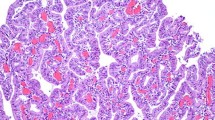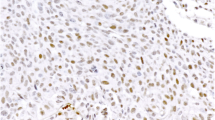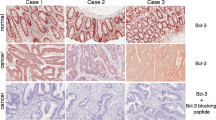Abstract
The c-myc oncogene has been implicated in the processes of normal cell proliferation and differentiation. Elevated levels of c-myc mRNA and its gene product (p62c-myc), have been detected in a variety of solid tumours and cultured cel lines. Its precise role in normal cell function and in neoplastic transformation and progression has yet to be elucidated. We have used a monoclonal antibody, raised by peptide immunisation, to determine the distribution by immunoperoxidase staining of the c-myc oncogene product in archival specimens of colonic polyps and carcinomas. Samples from 42 patients with colon carcinoma, 24 with benign polyps and 15 normal colon biopsies were examined. Normal colon revealed maximum staining in the mid-zone of the crypts, corresponding to the zone of differentiation and maturation. The staining was predominantly cytoplasmic. Adenomatous polyps revealed the most intense pattern of staining in areas of dysplastic change. Colonic tumours showed a wide range of staining. Well differentiated tumours contained more cytoplasmic p62c-myc than poorly differentiated tumours. These findings suggest that the c-myc oncogene product may play an important role in the evolution of colonic neoplasia.
Similar content being viewed by others
Rights and permissions
About this article
Cite this article
Stewart, J., Evan, G., Watson, J. et al. Detection of the c-myc oncogene product in colonic polyps and carcinomas. Br J Cancer 53, 1–6 (1986). https://doi.org/10.1038/bjc.1986.1
Issue Date:
DOI: https://doi.org/10.1038/bjc.1986.1
- Springer Nature Limited
This article is cited by
-
The effect of red blood cell disorders on male fertility and reproductive health
Nature Reviews Urology (2024)
-
Signatures of co-deregulated genes and their transcriptional regulators in colorectal cancer
npj Systems Biology and Applications (2020)
-
Genetic unraveling of colorectal cancer
Tumor Biology (2014)
-
Purinergic signalling in the urinary tract in health and disease
Purinergic Signalling (2014)
-
LIN28B fosters colon cancer migration, invasion and transformation through let-7-dependent and -independent mechanisms
Oncogene (2011)




